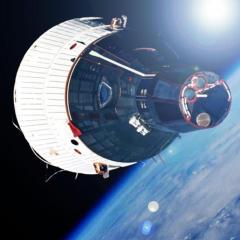Hypersonic flight has been talked about and researched for more than 60 years, but it remains rare outside of very limited applications. Hypersonic flight is defined as travelling at speeds above Mach 5.5, or more than five times the speed of sound.
Associate Professor Sean O’Byrne of UNSW Canberra, who researches and teaches aeronautical engineering, says there are several fundamental technical and economic problems that have held back hypersonic flight from becoming an everyday occurrence in Australia and around the world.
“One of the major issues is the economic viability. It is just too expensive. The Concorde – which was an example of supersonic rather than hypersonic – was economically marginal. But as well as economics there are some major technical issues like heat management, aerodynamics and fuel efficiency,” said O’Byrne.
“These must be solved to make a hypersonic passenger vehicle practical. So far, no one has made it economically viable to overcome these issues, but technically speaking it is certainly feasible, as it currently is for space travel and hypersonic missiles,” he added.
Several Australian universities and private organisations are making great progress in the area of hypersonic flight, and working to overcome technical challenges like fluid-structure interactions, propulsion, and materials to withstand the thermodynamic loads.
Fluid-structure interactions
Hypersonic and high-speed flow research at UNSW Canberra investigates the gas dynamics of chemically reacting and real-gas flows. These inform the design of the hypersonic propulsion systems and planetary entry systems.
“THIS IS A FUNDAMENTAL STUDY OF THE COMPLEX COUPLED PHYSICS THAT WILL INFLUENCE HOW A HYPERSONIC VEHICLE WILL DISTORT IN FLIGHT DUE TO THE EXTREME AERODYNAMIC AND THERMAL LOADS THAT IT IS SUBJECTED TO.”
Professor Andrew Neely
Professor Andrew Neely said at supersonic and hypersonic speeds, aircraft are subjected to aerothermal heating, reducing the stiffness and strength of the airframe, making the structure more susceptible to strong FSI.
“In certain cases, if this FSI coupling is not naturally damped out it can lead to reduced aerodynamic performance, structural fatigue and thus reduced life of the vehicle and potentially catastrophic failure,” he said.
A UNSW Canberra hypersonics experiment led by Professor Neely has been selected as a test case for a NASA-organised workshop in the US next year which will inform the design of vehicles that travel at hypersonic speeds.
The Aeroelastic Prediction Workshops bring together an international community of engineers and researchers who use computer simulations to model the complex physics of aeroelasticity and fluid-structure interactions (FSI).
“This is a fundamental study of the complex coupled physics that will influence how a hypersonic vehicle will distort in flight due to the extreme aerodynamic and thermal loads that it is subjected to,” Professor Neely said.
“It will help inform the development of computational tools to help confidently and efficiently design these vehicles.”
Propulsion
University of Queensland (UQ) is at the forefront of high-speed propulsion research and in 2002 conducted the first-ever atmospheric test of a scramjet. The UQ team has since made advances in atmospheric high-speed propulsion, and focused on how new and evolving technologies affect hypersonic flight systems, as well as vehicle design for planetary entry and hypervelocity flight.
The team from UQ’s School of Mechanical and Mining Engineering is working on a reusable scramjet launcher that could reduce launch costs and improve launch-date flexibility.
A scramjet is a supersonic combustion engine that uses oxygen from the atmosphere, making it lighter and more fuel-efficient than rockets and useful as an alternative to a rocket for launching satellites into space. Satellites are launched by a rocket, but once launch systems have travelled their designated trajectory, they drop away and fall into the ocean.
The researchers see this as a commercial opportunity where a scramjet can be more cost-effective than a rocket because it can be used many times over.
It would also suit companies that currently launch small satellites and employ what’s called a ‘tag along’. The small satellites are part of a bigger launch and are launched into orbit as the rocket goes up.
UQ has developed the SPARTAN small satellite launcher concept to achieve that.
Materials to withstand the thermodynamic loads
The University of Southern Queensland (USQ) is also undertaking ground-breaking research in the area of hypersonic flight.
One of the goals of the USQ team is to investigate materials for their high-temperature resistance and long durability to develop reusable launch vehicles and engines.
In conjunction with private company Hypersonix, they are developing a new DART CMP drone. At its core will be a 3D-printed Spartan hydrogen-fuelled scramjet engine. The Spartan engine burns hydrogen fuel in a process that emits water vapour, not carbon dioxide, as its exhaust.
The scramjet engine achieves internal combustion temperatures greater than 1000°C, and the airframe presents other challenges as it absorbs considerable stress as well as heat.
As the Spartan engine design has no moving parts, there are fewer potential points of failure. It uses the shockwaves and the air itself to create combustion making the engine more resilient, reliable and reusable.
Hypersonix is in the process of assembling its DART AE 3D-printing demonstrator craft, and will follow this with the DART CMP that will focus on integrating composite materials.
By using 3D printing, the company saves money and builds a more resilient and seamless assembly, and it takes just three weeks to print a new one.
The DART AE is due to launch in 2023.
This article was written by Nicola Rutzou and originally published at https://createdigital.org.au/the-biggest-challenges-to-hypersonic-flight/



